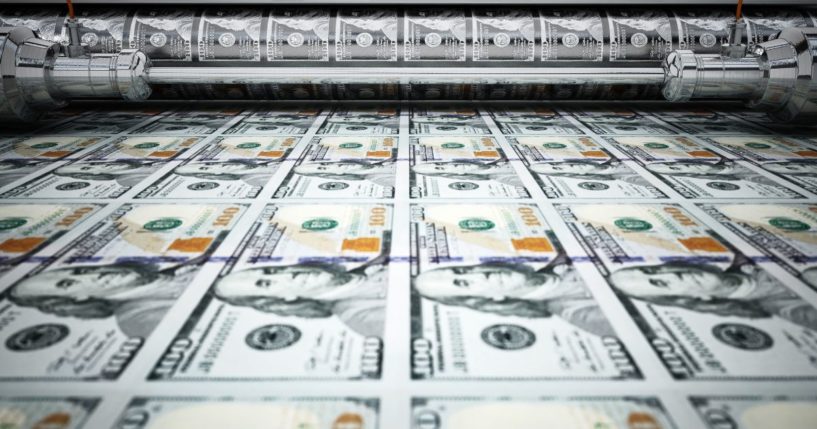
CBO Director: Federal Debt Trajectory Is 'Unsustainable,' Something Has to Give
Congressional Budget Office Director Phill Swagel told reporters on Wednesday that the fiscal path the federal government is on is unsustainable, and new spending measures passed under the Biden administration are partly to blame.
The CBO projects in a new report that the national debt will grow from its current approximately $31.5 trillion to $46.4 trillion by 2033 if policies stay the same.
The debt stands at 98 percent of the country’s gross domestic product, but will be at 118 percent by 2033 and 195 percent by 2053.
The only other time in U.S. history that the federal government carried a debt load equaling the economy’s total output was during World War II.
“The debt trajectory is unsustainable,” Swagel said at a news conference, according to The Associated Press.
The CBO cannot tell Congress what to do, he added, “but at some point, something has to give — whether it’s on spending or revenue.”
Based on the CBO’s latest projections, “the federal budget deficit totals $1.4 trillion in 2023, and deficits average $2 trillion over the 2024 to 2033 period. So those projections reflect the assumption that current laws governing federal taxes and spending generally remain unchanged,” Swagel said.
The director stated that new legislation enacted under President Joe Biden and the Democrat-controlled Congress has caused the CBO estimates on federal deficit spending over the next decade to rise significantly.
“The cumulative deficit over the 2023 to 2032 period that we now project is $3 trillion larger than we projected last May, mainly because of newly enacted legislation and changes to the economic forecast that boost interest costs and spending on mandatory programs,” Swagel said.
The Federal Reserve began raising interest rates in March 2022 to combat inflation, which economists on both sides of the political aisle partly attribute to the massive fiscal stimulus and deficit spending under Biden.
Interest payments on the national debt will reach over $1 trillion per year by 2029 on the nation’s current fiscal trajectory, the CBO predicts.
.@uscbo Director Phillip Swagel: “We project that if the debt limit remains unchanged the government’s ability to borrow using these extraordinary measures will be exhausted between July and September of 2023…that projected exhaustion date is uncertain.” pic.twitter.com/uFXHqhEHw9
— CSPAN (@cspan) February 15, 2023
GOP Rep. Jodey Arrington, chairman of the House Budget Committee, responded to the CBO report, saying, “Biden’s numerous bailouts and massive government expansion disguised as COVID relief has blown out spending and exacerbated our debt disaster.”
“House Republicans must rein in the unbridled spending and restore fiscal sanity in Washington before it’s too late,” he added.
Among the new major programs passed since Biden took office were the $1.9 trillion American Rescue Plan, the $740 billion Inflation Reduction Act and the $1 trillion infrastructure bill.
Democratic Sen. Sheldon Whitehouse, chairman of the Senate Budget Committee, pointed to the 2017 Tax Cuts and Jobs Act passed under former President Donald Trump as part of the problem.
Republicans “deliberately” made the deficit worse with “massive revenue losses because they lowered tax rates for their corporate and billionaire friends and donors,” he charged.
The Joint Committee on Taxation estimated the tax cuts would increase the deficit by $1 trillion over the next decade, while the Tax Foundation calculated they would cost $1.47 trillion; however, the foundation added the tax reductions would spur $1 trillion in new revenues through increased economic growth.
The tax cuts worked as advertised by the Republicans, with revenues to the Treasury hitting an all-time high of over $4 trillion in fiscal year 2021, followed by a new record of $4.9 trillion in FY 2022 with the Trump tax cuts still mostly in place.
In 2017, when the legislation passed, total revenue to the Treasury was $3.3 trillion.
For some further perspective, the federal government spent $4.4 trillion in 2019, so with some fiscal restraint the budget could have been close to being balanced now. Unfortunately, expenditures in FY 2022 were $6.27 trillion, leading to a $1.38 deficit for the year.
The Wall Street Journal’s editorial board wrote in a Wednesday opinion piece titled “Biden’s Federal Budget Blowout” that “White House spinners are boasting that Joe Biden’s Presidency has been historic, and in one sense they’re right. In a mere two years he has midwifed the biggest expansion of government since the 1960s.”
“Revenues last year hit 19.6 percent of GDP, far above the 17.4 percent average over the last 50 years, and a share of the economy reached only in 1944, 1945 and 2000. The overall federal tax burden is higher than ever, and the American taxpayer is paying more than his fair share,” they continued.
“Now look at the spending side of the ledger. Outlays reached 24.8 percent of GDP last year, far above the 21 percent 50-year average. … If you’re a socialist who wants politicians to control more of the means of production, Joe Biden is your man,” the board argued.
During his briefing, Swagel pointed out that the federal debt ceiling was reached on Jan. 19, but the Treasury has been taking “extraordinary measures” to borrow additional funds.
The CBO projects the Treasury’s ability to employ these measures will be exhausted sometime between July and September, depending on revenues that come in by April’s federal income tax deadline.
“If the debt limit is not raised or suspended before the extraordinary measures are exhausted, the government would be unable to pay its obligations fully,” Swagel said. “As a result, the U.S. government would have to delay making payments for some activities, default on its debt obligations, or both.”
A version of this article originally appeared on Patriot Project.
Truth and Accuracy
We are committed to truth and accuracy in all of our journalism. Read our editorial standards.
Advertise with The Western Journal and reach millions of highly engaged readers, while supporting our work. Advertise Today.












